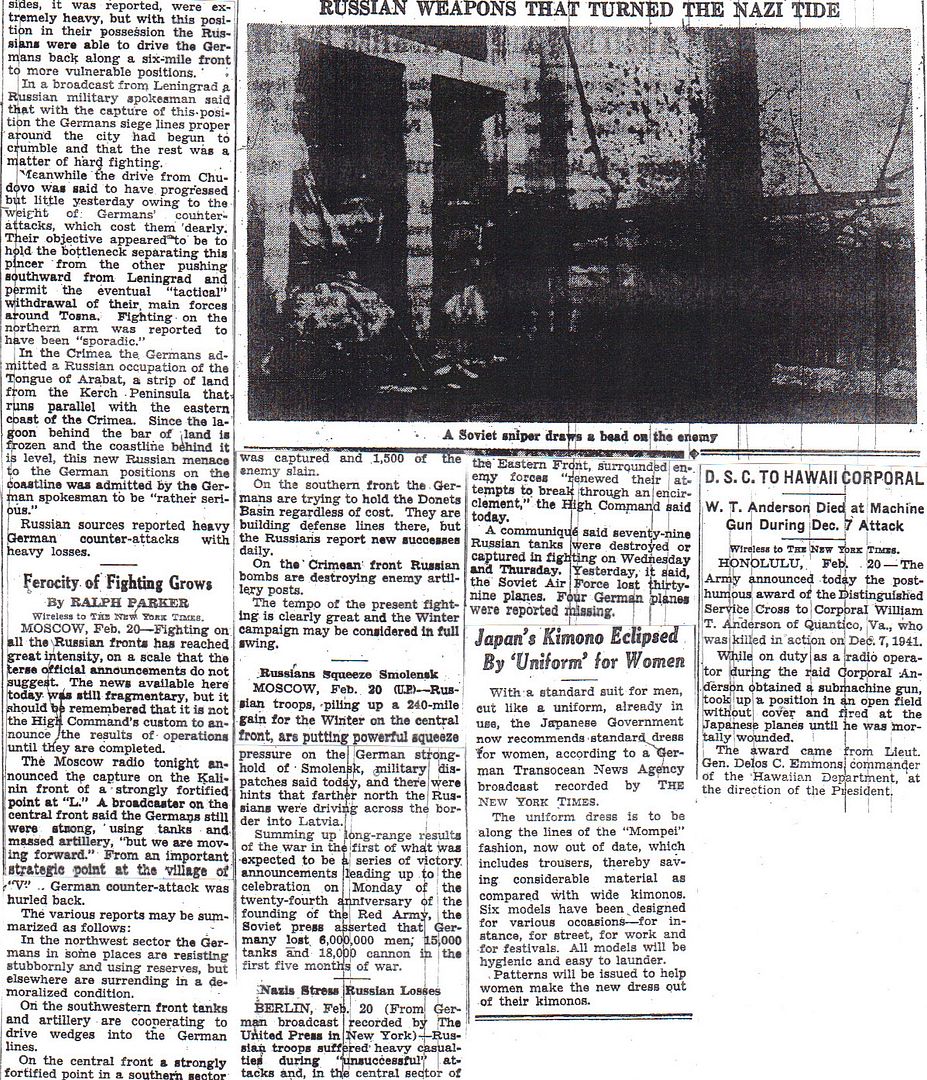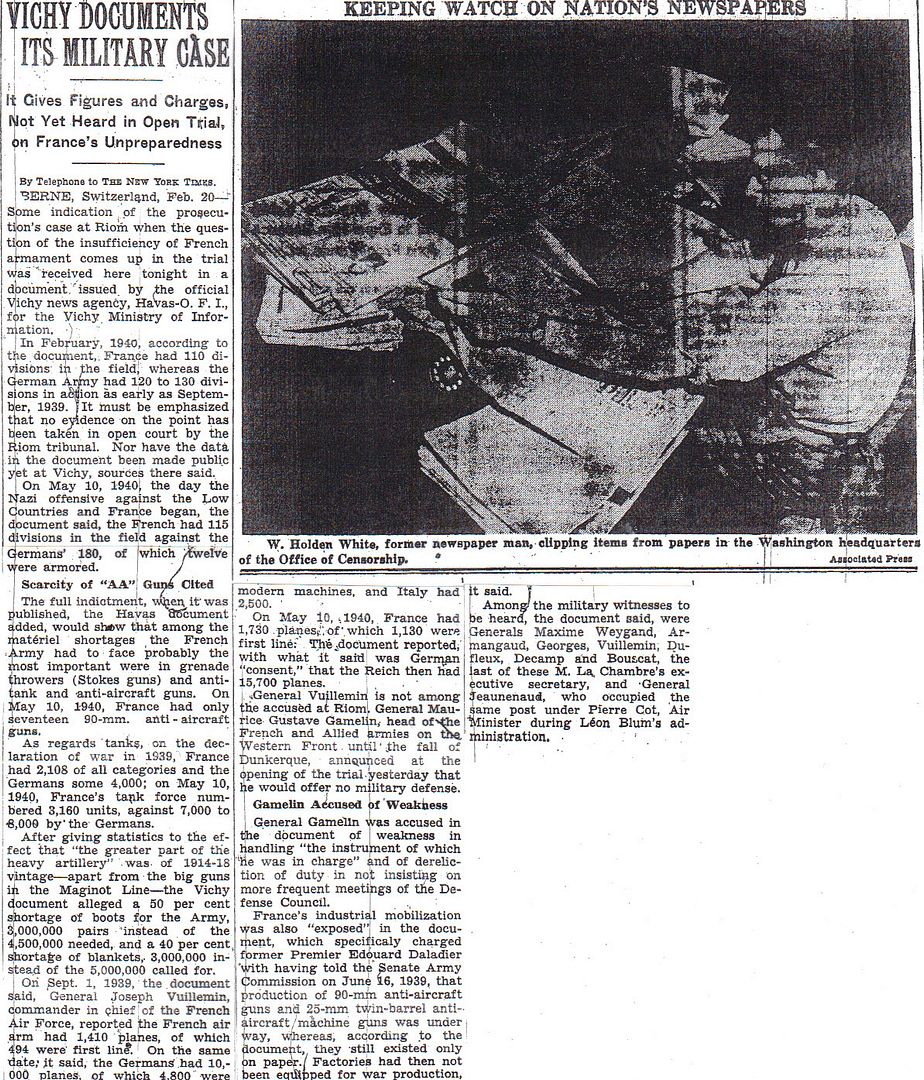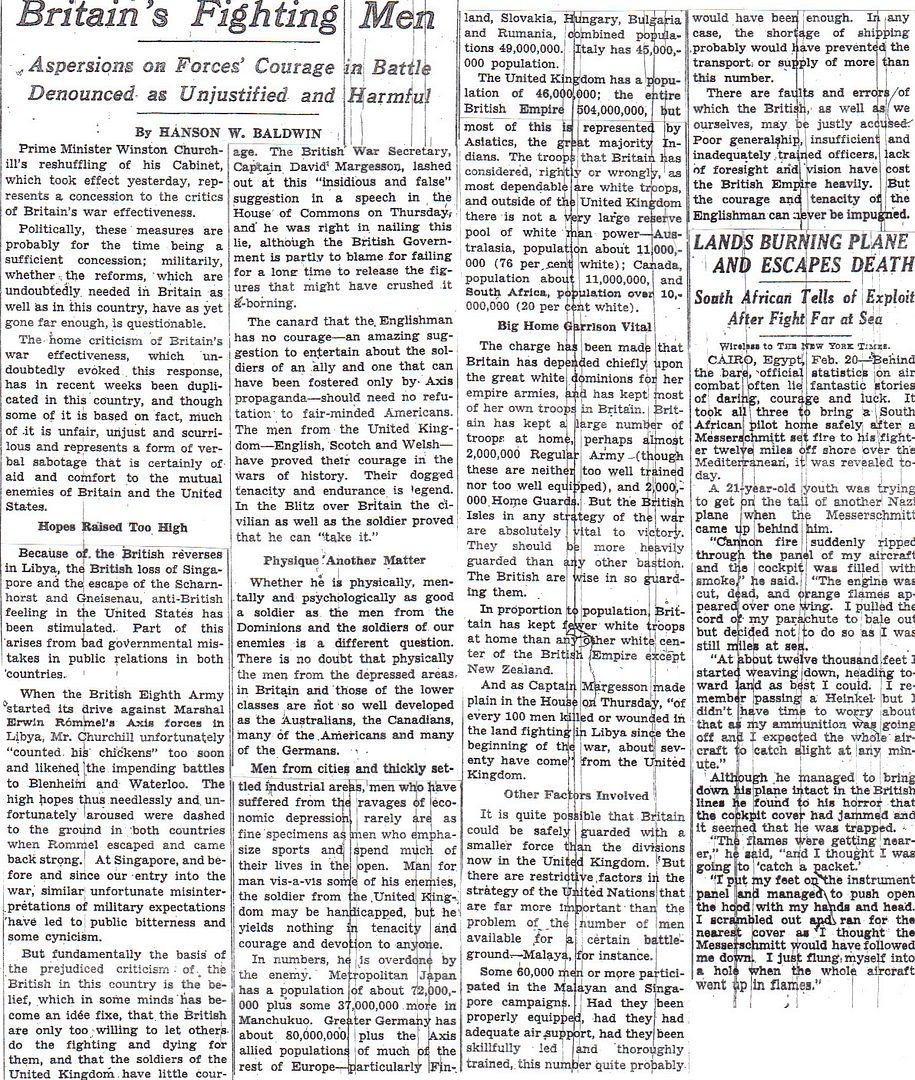
Posted on 02/21/2012 4:37:10 AM PST by Homer_J_Simpson














* Here is a better look at the General’s Battle Mien. Try not to swoon.
http://www.onwar.com/chrono/1942/feb42/f21feb42.htm
German capital ships to be based in Norway
Saturday, February 21, 1942 www.onwar.com
Prinz EugenFrom Germany... The pocket-battleship Admiral Scheer and the cruiser Prinz Eugen leave for bases in Norway.
In Burma... The British 17th Indian Division begins retreat to the Sittang River through Kyaikto.
http://homepage.ntlworld.com/andrew.etherington/month/thismonth/21.htm
February 21st, 1942
UNITED KINGDOM: Destroyer HMS Opportune launched.
Light cruiser HMS Gambia commissioned.
Minesweeper HMS Arcturus laid down. (Dave Shirlaw)
VICHY FRANCE: US Ambassador Admiral William D. Leahy USN (Retired), receives an instruction to see French Vice Premier Admiral Jean Darlan immediately about German submarine U-156’s receiving assistance at Martinique. Unless the Vichy French can assure the U.S. government that no Axis ships or planes will be allowed to enter French ports or territory in the Western Hemisphere, and that unless such assurances are rigidly maintained, the United States “will take such action in the interest of security of the Western Hemisphere as it may judge necessary and in accordance with existing inter-American obligations.” Leahy writes in his diary that everything points to his early recall to Washington “for consultation.” (Jack McKillop)
THE NETHERLANDS: During the night of the 20-21st, two RAF Bomber Command Manchesters drop mines off the West Frisian Islands. (Jack McKillop
BELGIUM: During the night of the 20-21st, one RAF Bomber Command aircraft visually bombs the port area at Ostend. (Jack McKillop)
GERMANY: The German naval warships, Admiral Scheer and Prinz Eugen leave Germany for Norway.
During the night of the 20-21st, 21 RAF Bomber Command aircraft visually bomb eight cities. Six bomb Koblenz, five bomb Mannheim, three bomb Frankfurt-am-Main, two each bomb Aachen and Cologne, and one each bombs Darmstadt, Dortmund and Karlsruhe. (Jack McKillop)
U-490, U-923 laid down.
U-184 launched.
U-210, U-441, U-515, U-516 commissioned. (Dave Shirlaw)
NORWAY: During the night of the 20-21st, eight RAF Bomber Command aircraft attack four airfields to provide a diversion for a Fleet Air Arm strike from the aircraft carrier HMS Victorious on the German heavy cruiser Prinz Eugen, which had taken shelter in a Norwegian fjord near Trondheim after being torpedoed and damaged by the submarine HMS Trident. The Fleet Air Arm strike was not successful, because of poor weather conditions. Five aircraft attack Lista and one each attack Christiansand, Mandel and Stavanger. The aircraft attacking Stavanger is lost. (Jack McKillop)
INDIA: Chiang Kai-shek makes a broadcast asking the people to support China and the Allies in their war against Japan.
INDIAN OCEAN: The Canadian Tramp Shipping Line merchantman Canadian Cruiser (7,178 GRT) was sunk in the western Indian Ocean north of the Mozambique Channel, in position 06.36S, 047.18E, by the German armoured ship, or ‘pocket battleship’, Admiral Scheer, KptzS Theodore Kranke, CO. The entire crew of thirty-six men was taken prisoner. Canadian Cruiser was carrying a load of iron ore to Durban, South Africa. She was sighted by Admiral Scheer’s floatplane at 09:15 and was finally intercepted in the afternoon. The master claimed to be an neutral American ship but the Germans insisted on boarding to search her, at which point Canadian Cruiser tried to get underway and began transmitting a distress signal. Admiral Scheer opened fire with light AA guns and forced her to take the way off the ship. A boarding party inspected the ship and her documents, which revealed her true identity. Five scuttling charges were set and detonated, which quickly sent the heavily laden ship to the bottom. One of Canadian Cruiser‘s crewmembers, Ordinary Seaman W.H. MacArthur, later escaped from a prisoner of war camp near Bordeaux, France, and made his way home, via Spain. Although many ships had received her original distress signal, it was not until MacArthur returned that her fate was established with certainty. (Dave Shirlaw)
BURMA: Burma is removed from the jurisdiction of the ABDA Command. The British 7th Armoured Brigade arrives at Rangoon from the Middle East and is soon committed on the Pegu front. The Indian 17th Division continues toward Sittang bridge near Mokpalin with the Japanese in close pursuit. (Jack McKillop)
American Volunteer Group (AVG, aka “The Flying Tigers”) and RAF pilots mistakenly attack a column of Indian troops northeast of Rangoon, killing 160 and destroying or damaging scores of vehicles. (Jack McKillop)
THAILAND: During the early afternoon, pilots of the 1st Fighter Squadron, American Volunteer Group (AVG, aka “The Flying Tigers”) attack Tak Airdrome at Rahaeng and destroy two bombers and a fighter. (Jack McKillop)
COMMONWEALTH OF THE PHILIPPINES: A lull settles over the entire front on Bataan as both sides dig in and prepare for further action. The Japanese have completed their withdrawal from I Corps area; diversionary forces employed against II Corps are ordered back to the Balanga area. (Jack McKillop)
The U.S. War Department orders General Douglas MacArthur, Commanding General U.S. Army Forces, Far East (USAFFE), to move his headquarters to Mindanao Island and then go to Australia to take command of Allied forces in the Southwest Pacific. MacArthur threatens to resign his commission and join the Bataan defence forces as a volunteer, but his advisers talk him out of it.
The blockade runner Elcano brings 1,000 tons of food to Corregidor. This is enough to feed Bataan for four days. (Jack McKillop)
EAST CHINA SEA: The submarine USS Triton (SS-201) sinks a Japanese merchant cargo vessel 60 miles (97 kilometres) south of Quelpart Island. (Jack McKillop)
NETHERLANDS EAST INDIES: Major General George H Brett, Deputy Commanding General ABDA Command informs the U.S. War Department of his decision to evacuate the USAAF 5th Air Force and other US troops from Java. (Jack McKillop)
On Java, USAAF 5th Air Force bombers based in Java bases fly about 20 strikes, usually in two and three aircraft elements, against shipping in the Java Sea and against targets on Bali from this date through 1 March. Eleven strikes are complete failures; the remainder, although causing some damage to vessels and airfield facilities, fail to deter the invasion of Java. During the morning, USAAF 5th Air Force P-40 pilots shoot down five Mitsubishi A6M, Navy Type 0 Carrier Fighters (to be given the Allied Code Name “Zeke”). (Jack McKillop)
On Java, General Archibald Wavell, Commander in Chief ABDA Command, warns British Prime Minister Winston Churchill that the Japanese will soon complete the conquest of the Netherlands East Indies and capture nearly 100,000 Dutch, British, Australian and U. S. troops. (Jack McKillop)
On Dutch West Timor, the Australians begin an attack on the village of Babau at 0530 hours; by the end of the day, the Australian have occupied it. (Jack McKillop)
AUSTRALIA: After the government confirmed its decision that all Australian Imperial Force troops should be returned to Australia instead of serving in Java, Lieutenant General Vernon Sturdee, Chief of the Australian General Staff, cables General Sir Archibald Wavell, Commander-in-Chief American-British-Dutch-Australian (ABDA) Command, that Lieutenant General John Lavarack, General Officer Commanding I Australian Corps, and his staff should be evacuated from Java as soon as possible. Sturdee also urges Wavell to evacuate the Australian troops that disembarked from the SS Orcades at Batavia, Java, on 18 February. (Jack McKillop)
U.S.A.: Escort carrier USS Card launched.
Submarines USS Tinosa and Lapon laid down. (Dave Shirlaw)
CARIBBEAN SEA: An unarmed U.S. tanker is torpedoed and sunk by German submarine U-67 about 225 miles (362 kilometres) west of Aruba, Netherlands East Indies. (Jack McKillop)
At 1532, the unescorted SS Kongsgaard was attacked by U-67 with two torpedoes seven miles off North Point, Curaçao. The master saw one torpedo and he tried to evade, but one of the torpedoes struck on the port side between the bridge and the poop deck. The cargo caught fire; sending flames high above the entire afterpart. A dinghy was thrown overboard, whereupon two men tried to save themselves in it, but the flames caught up with them. Some men amidships lowered the starboard boat and then rowed away as fast as they could, after having fished some men out of the sea. At 1902, the U-boat fired a coup de grâce, which missed and at 1930 a second, which struck the afterpart and caused the tanker to sink about seven miles west of North Point. The master and six survivors in the lifeboat were rescued by a fishing vessel three hours later and taken to Curaçao. An eight survivor was also picked up; he jumped off the afterpart and swam through the flames, which had quickly spread on the water after the explosion, until he reached open water.
At 2113, motor tanker Circe Shell, dispersed from Convoy ON-60, was torpedoed and sunk by U-161 20 miles west-northwest of Port of Spain, Trinidad. One crewmember was lost. The master, 51 crewmembers and five gunners were picked up by the British tug Busy and landed at Port of Spain on 23 February. (Dave Shirlaw)
ATLANTIC OCEAN: On convoy escort destroyer HMS Montgomery rescued the survivors of Scottish Standard. USS Wickes (DD-75), was commissioned as HMS Montgomery (G-95) on 25 Oct. 1940. (Ron Babuka)
An unarmed U.S. tanker is torpedoed by German submarine U-504 about three miles (4,8 kilometres) east of Jupiter Inlet, Florida. (Jack McKillop)
U-432 spotted a steamer of 5000 GRT in heavy seas about 125 miles ESE of Ocean City, Maryland. A first torpedo missed and the U-boat then crossed behind the steamer to the port side. At 0123 a second torpedo was fired at 800 meters, which hit the freighter amidships. At 0242 a third torpedo struck forward of the bridge. It is assumed that this ship was SS Azalea City and that the nature of the cargo caused the ship to capsize after the torpedo hits. None of the eight officers and 30 men on board survived.
At 1044, motor tanker Egda was torpedoed by U-107 after the ship had left Convoy ON-65 to proceed to the USA alone. U-107 was on her way home with only two torpedoes left. One torpedo struck on port side between the #3 and #4 wing tanks, but she did not sink and reached Halifax safely under own power and continued to New York for repairs. (Dave Shirlaw)
The George Gallup story about income tax withholding is arguably the most important story in the NY Times for this date.
http://destroyerhistory.org/destroyers/federal/
Federal Shipbuilding & Dry Dock Co. was originally located at Kearny Point, Kearny, New Jersey on the west bank of the Hackensack River, about three miles from today’s Newark International Airport. A subsidiary of United States Steel Corporation, it was organized in 1917 for the construction of steel ocean-going vessels.
From 1930 through the last of the Gearing class, Federal built more destroyers than any other builder except Bath Iron Works, including the lead ships of the Somers, Benham, Fletcher, Allen M. Sumner and Gearing classes. Federal’s Gearings were built at a separate facility, completed during the war, at Port Newark, New Jersey.
I would agree with you.
That shipyard will get a mention in our lead story next Saturday.
So if ADMIRAL SCHEER is in the Indian Ocean, is LUETZOW [formerly DEUTSCHLAND] the ship accompanying PRINZ
eugen to Norway?
In addition to building a large number of destroyers (DD), Federal built most of the light cruisers (CL) of the Atlanta class.
http://en.wikipedia.org/wiki/Atlanta_class_cruiser

Interesting that it was described here as something the little man wanted. Back in the day, it seems, he was expected to pay income taxes too.
One might say the type-95 had the frontal profile of an inverted V but the type-95 had a 37mm gun, 7.7mm machineguns and 12mm armor plate that could be penetrated fairly easily by .50 cal AP.
Yes and no.
Admiral Scheer is not in the Indian Ocean, but Lutzow is accompanying Prinz Eugen to Norway. The KM will concentrate most of their remaining surface forces for use in the northern waters. Right now it’s Tirpitz, Lutzow & Eugen. They will be joined by Scharnhorst & Hipper later. Gneisenau is headed for the scrapyard and Scheer, I believe, will remain at Kiel.
Tirpitz will just sit in port for the most part until the Brits finally bag her. Scharnhorst will be sunk off the North Cape by HMS Duke of York and cruisers Belfast, Sheffield, Norfolk & Jamaica on Boxing Day 1943. The rest of the KM (Hipper, Scheer, Lutzow & Eugen) will see extensive action in 1945 providing fire support to German army units in East Prussia.
Either the “experts” don’t know what they are dealing with in the Japanese arsenal or they aren’t letting on what they know.
The Japanese tanks were laughable by western standards and would never have held up on the Eastern Front. Japan possessed neither the motor nor steel industry to build anything like the T-34 or Panzer IV. But then again, they didn’t need to. The Chinese didn’t have any tanks, and light tanks worked best for amphibious and jungle operations. We made extensive use of the Stuart light tanks for the same purpose.
As for the description of their amphibious assault ships, again, the writers are either ignorant or deliberately cagey. The assault ship that “looks like a modern whaling vessel?” Well, it probably was one, as the Japanese took their whaling factory ships and pressed them into use as various forms of tankers or transport ships. The “wide variety of landing barges?” Can we say: “grab anything that floats and use it?”
What was not widely appreciated at the time is that while the Japanese possessed first-rate fighting ships and aircraft, their maritime logistical support was always on a shoestring. They entered the war short of merchant shipping tonnage needed, and as their empire expanded and shipping transit times increased, the shipping pinch only became greater. Also, they were never able to build anything like what they needed. Even at this point in the war, for every two merchant ships we sink, they can only replace one of them.
They are not the juggernaut they seem to be. But since they haven’t been beaten anywhere during their impressive Pacific Blitzkrieg, and I can see where people have to wonder at this point if they can be stopped.
USS Lansdowne, launched today, will have an interesting career.
She will be credited with sinking U Boat in the Atlantic, will have a torpedo launched by Japanese submarine I-19 pass under her, and will transport the Japanese surrender delegation to the USS Missouri in Tokyo Bay.
The I-19 torpedo was one from the most successful torpedo spread ever launched. On September 15, 1942, the I-19 sights the American carrier task force and gets past the escort screen to launch her spread. Of the six torpedoes launched, one passes under Lansdowne, two or three strike CV-7 USS Wasp, one strikes DD 415 USS O’Brien, one strikes the bow of USS North Carolina and one just misses USS Hornet. The damage to O’Brien and Wasp is mortal, North Carolina makes it back to Pearl for repairs.
I suspect at this point the experts don't want to let the Japanese know too much about what we know.
The Japanese tanks were laughable by western standards and would never have held up on the Eastern Front.
A point emphasized in Aug 1945 when Red Army T-34-85 and IS-2's rolled over the Japanese Kwantung army.
Disclaimer: Opinions posted on Free Republic are those of the individual posters and do not necessarily represent the opinion of Free Republic or its management. All materials posted herein are protected by copyright law and the exemption for fair use of copyrighted works.